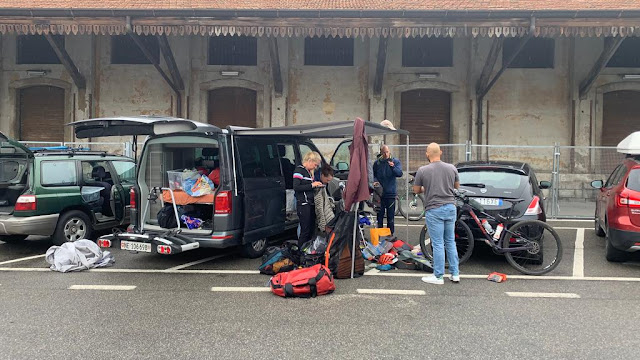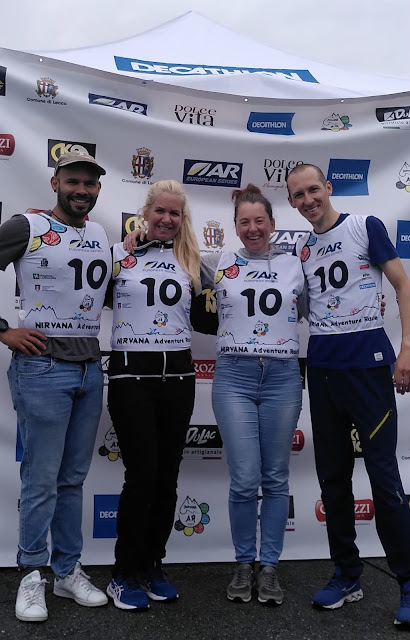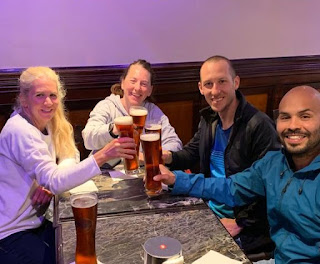 |
Lake Como
|
Nirvana. The name alone is irresistible. From there it only gets better. Raid Nirvana is a 150-km adventure race (AR) located in and around Lake Como with it’s tranquil waters, picture-postcard villages, friendly locals and all of it cradled gently in a ring of majestic mountains. A more idyllic and spectacularly scenic location is hard to find.
The invitation to join a Swiss team came from Lucas, a friend I’d raced and trained with before, who I got along with well, and who had tons of AR experience dating back to his upbringing in Columbia. And despite having another race already on the calendar two weeks later, this one I couldn’t resist. Nirvana was calling.
 |
Race Plan
|
The other two team members were new to me. Lucas had already raced before with Laure, a French woman, and the fourth, David, was a ‘last minute’ replacement for his training partner. David was young and strong but a newbie to both AR and ultra-endurance sports. He’d done some long-distance triathlons, and although the two sports share similarities, the speed, environment and time span are like comparing apples and oranges. For this reason it is completely common and acceptable to match up young, strong competitors with those who are older and experienced. It’s a team sport in which diversity offers stability and resiliency as long as the chemistry amongst the individuals works. And it worked with us. It was clear as soon as we met that we would all get along. Right from the start, the conversation flowed easily, even though we were of four different nationalities and the same number of mother tongues.
 |
| Logistics and organization (although it doesn't look very organized) |
 |
| Team Powerbar Swiss Explorers! |
We met at 10am in the parking lot of the race organization where the start and finish were to be held. The race briefing was scheduled for 8pm that night, with the start scheduled for 9pm. Even with the somewhat restricted timeline, packing transition bags and planning race strategy were done with ease and calm. We were allotted a bike bag, a paddle bag and a transition bag. Our bike bag was limited to contain only our bike shoes and over-shoes for warmth, which we all had since the weather was expected to be cold up in the mountains, intensified by the rain. Our paddle bag was a large mesh sack which was to hold our PFDs (life vests), paddles, paddle gloves, shoes or whatever gear we’d need in the boats but no other items such as clothing or food. We’d get the transition bag about half-way through the race prior to the longer trekking stage and in that we could store food supplies, gear and clothing. Once we’d finish discussing the race stages, transitions and strategy, we had a few hours to rest and eat before heading to the briefing.
We arrived at the race briefing around 7:30pm and shortly after 8 we were given the maps. With maps in hand, the race director was still relaying important information, but once you have the maps and the count-down is on, paying attention to anything else is a challenge. I was dying to start marking maps but there is critical info that you don’t want to miss, such as having to disembark from the boats at the dam and carry them to the other side; the long difficult march after the paddle stage and to follow the marked path; that the gate at the railroad crossing was welded shut and we’d have to heave our bikes over the gate and climb over the barbed wire. Finally all info was relayed and we could concentrate on the maps: David, as lead navigator, marking a full set with Lucas, while Laure and I marked a second set of trekking maps.
The sun went down, it got dark, the rain started, and at 9:00pm on the dot we were on our way, racing through the streets of Lecco with headlamps on, map in hand and full gear on our backs. The first leg was a short urban orienteering stage which sent teams in all directions collecting five checkpoints before heading to the shores of the lake to assemble our paddles, get into our PFDs, and shove off in our kayaks for the first longer stage, a 14-km paddle southwards till the lake transformed from a massive waterway to a narrow river-like inlet and eventually to a marsh.
But the start didn’t go off as hoped for.
The kayaks were not rigid but rather of the inflatable type, which are difficult to maneuver unless you’ve had some experience with them. This had Laure and David, who were in a boat together, going in circles. Lucas and I were quite a bit ahead and after about 30 minutes I asked Lucas if he could see our teammates. He replied that they were one of the three boats ahead of us. I said that I was pretty sure that they were behind us. And after closely inspecting the teams up ahead we realized that our teammates were not only NOT in the group ahead of us, but also not in the small bunch of boats behind us. We’d have to wait and let them catch up. This, of course, is part of the sport. To fruitlessly expend so much energy and then have to sit still and wait may be frustrating but it was our own fault for not having stayed close together from the start. But we knew that we weren’t fighting for the podium anyway. As a team we all have our own strengths and weaknesses, and throughout the event at some stage you have to wait for everyone. And on the bright side, even in the drizzling rain, the lake glistened under the lights of the villages dotting the hillsides. It was magnificent. There was no place I could imagine that I’d rather be.

Once reunited with David and Laure who were also frustrated at having to learn the hard way to maneuver an inflatable kayak, we decided to put a tow line on them and stick together. Although this kept us as one unit, it was a huge strain on the front boat, especially Lucas who was aft. He had the difficult task of being the pack-horse and maintain course. David had to use his paddle in the rear boat to keep them moving straight, while Laure and I just paddled blindly, trying to keep in tempo with Lucas’ tact calls.

Half-way through the stage we were confronted with the dam at which point we needed to go up on-shore, get a check-point, and then carry the boats adjacent to the shoreline and to the other side of the water-work. Then things got tricky. The water level was low. It was dark. There were difficult-to-discern sandbars and a couple times we got stuck. After briefly trying to push ourselves off with our paddles, Lucas gave up on keeping his feet dry (which was a premonition for what was to come) and he climbed out of the boat and dragged the two boats to deeper water. After a couple of hours of paddling and another check-point in a side inlet, we finally saw the exit point and were relieved to disembark, but unfortunately the transition area was about 500 meters away through a marsh. And we had to transport the boats all the way to the transition. So we each took hold of an end of the now water-filled kayaks and sloshed our way through sometimes knee-deep boggy ground. This was much more physically strenuous for me than the paddling, as it was tough enough just walking but also having to grip and hold the weight of the kayak with the chronic joint pain in my thumbs. Several times I had to put the boat down and re-grip. Then once we got to more even, stable ground, I took the backpacks and carried them while Lucas dragged our boat. Finally at T2.

There were three teams in the transition area when we got there. It was located in a material storage warehouse. It was not warm in there but it was sheltered from the rain. We moved fast in order to keep our body temps up. I stripped down out of my wet clothes and put on dry bike clothes, then repacked essentials quickly and we were out of the TA before the other teams. The race marshals checked to be sure we all had front and rear bike lighting and then we were back off into the darkness.
Only about the first kilometer was flat, and then it was up and up, and up some more. And then when you thought it couldn’t possibly continue going upwards, what happened? We’d round a bend and see the trail continue upwards even higher. It varied between paved roads that were rideable to steep muddy paths, some of which were in such poor condition due to the rains that even pushing the bikes over some sections was all but impossible. We had to carry and climb, slip and fall, push and be pushed. David and Lucas helped me a lot on the bike, with a hand on my back during the road ascents and even David quickly riding or pushing his bike up the steep trails then running back down to grab mine. This continued for about 3 hours before we had a slight reprieve with an exhilarating serpentine descent of about 30 minutes ahead of the next multi-hour push and shove up the next mountain peak until the morning began to break. Around six am the first rays of light began to appear and the mood immediately went from somber to light-hearted and optimistic. Laure was singing and making jokes and I felt intoxicated by her positivity. After six hours of nearly just climbing, the last 30 minutes was another descent, this time over rocky trails that had us carefully navigating the ruts, but it was a welcome reprieve from the strenuous uphill slog.
The next transition area was in a small sports club building. There was a fire lit, coffee and a few plastic chairs where we sat for a few minutes while changing our clothes and shoes for the next trekking section. It was 07:30 am when we set off for the next leg, back up into the hills where we’d just spent the night.

I was exhausted, which was not typical for me this early in a race. But I knew why and was worried about it and whether I would be able to make it to the finish line. I’d been sick with Covid-19 just two weeks earlier. I had been down for about 10 days with a fever, couch, congestion and exhaustion. But I had been feeling better for about a week and figured that since all my training had gone well prior to being sick, that maybe I could fight it out and make it to the finish of this relatively short race. It wasn’t like I was huffing and puffing, but it was clear that my lungs weren’t functioning right because my muscles seemed to suffer from oxygen deficiency. I had no energy. Nothing in the tank.
 |
| Short nap before the via ferrata |
I could jog quite effortlessly on flat sections, and we were moving along at a pretty good pace, but traversing uphill was a battle for me. It was also pretty clear to my teammates that I was in a bit of trouble. After a couple of hours on our feet we were approaching the via ferrata section after which we would have a considerable climb to the peak. It was time to make a decision. Did I want to attempt it? It would be easy to turn back now, but not half-way up the mountain. I knew that I was rapidly slowly down, and did I have to energy to climb? But I was determined to get everything I could out of the race that my body could offer, so I suggested we take a short break at the base of the climbing wall, then move on. We put on our climbing gear and lay down for about 10 minutes of shut-eye, after which I felt better, but not great. We moved ahead slowly and my teammates were absolutely amazing with me, taking time to be sure that I was climbing safely and waiting patiently each time that I had to sit to take a breather. I was in good hands.
 |
| Cozy warm hut on the mountain top |
It became colder as we ascended and we had to stop to put on jackets. The rain had stopped but the weather was overcast and a low fog restricted any views over the lake which would have been breathtaking from that perch. So we climbed blindly. Several times we stood off to the side to let a few sky-runners pass through, quick and light on their feet. At last the peak came into view and after collecting the check-point we retreated into the mountain hut that was thankfully open and serving the few brave climbers. Inside we were thrilled to find a fire lit, which I settled myself close up against. We ordered Cokes, relaxed and re-grouped. It was then that I hesitantly admitted that I would have to call it quits at the next transition area. I was a near-empty shell. The team, although mega disappointed, agreed without question. This is a team sport and if one is out, all are out. They could have continued on out of ranking, but they also decided to call it a day and save some precious energy for the next race on the calendar which was only two weeks away.
 |
| All teams at the finish! |
In the end, the weather had created such horrendous conditions for the first bike leg that it forced most teams early onto short course and only three teams finished the full course. This sport is like no other: unpredictable, exhilarating, dangerous, multi-faceted and thoroughly addictive.
And although I didn’t come home with a medal, I did arrive home safely with another ‘adventure’ in the books.
 |
| Cheers and till the next one! |














No comments:
Post a Comment